-
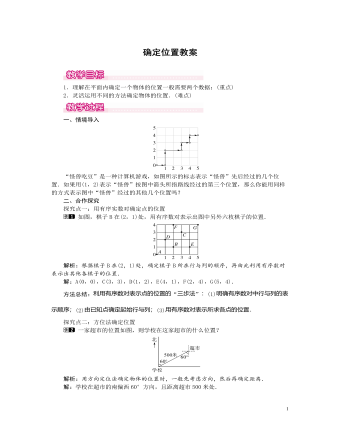
北师大初中数学八年级上册确定位置1教案
解析:要在地球仪上确定南昌市的位置,需要知道它的经纬度,故选D.方法总结:本题考查了坐标确定位置,熟记位置的确定需要横向与纵向的两个数据是解题的关键.【类型二】 用“区域定位法”确定位置如图所示是某市区的部分简图,文化宫在D2区,体育场在C4区,据此说明医院在________区,阳光中学在________区.解析:本题首先给出的是表示文化宫和体育场的位置,即D2区和C4区,这就确定了本题中表示建筑物位置的方法,即字母表示列数,数字表示行数.故填A3,D5.方法总结:解此类题先要弄清区域定位法中字母及数字各自表示的含义,再用已知的表示方法来确定相关位置.三、板书设计确定位置有序实数对方位法经纬度区域定位法将现实生活中常用的定位方法呈现给学生,进一步丰富学生的数学活动经验,培养学生观察、分析、归纳、概括的能力.教学过程中创设生动活泼、直观形象、且贴近他们生活的问题情境;另一方面,为学生创造自主学习、合作交流的机会,促使他们主动参与、积极探究.
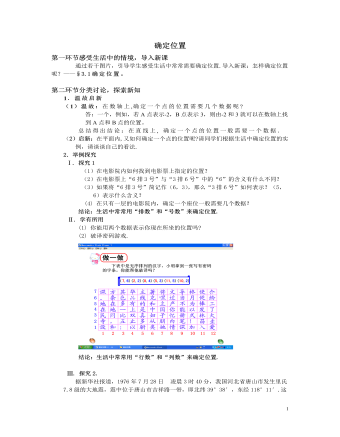
北师大初中数学八年级上册确定位置2教案
第一环节感受生活中的情境,导入新课通过若干图片,引导学生感受生活中常常需要确定位置.导入新课:怎样确定位置呢?——§3.1确定位置。第二环节分类讨论,探索新知1.温故启新(1)温故:在数轴上,确定一个点的位置需要几个数据呢? 答:一个,例如,若A点表示-2,B点表示3,则由-2和3就可以在数轴上找到A点和B点的位置。总结得出结论:在直线上, 确定一个点的位置一般需要一个数据.(2)启新:在平面内,又如何确定一个点的位置呢?请同学们根据生活中确定位置的实例,请谈谈自己的看法.2.举例探究Ⅰ. 探究1(1)在电影院内如何找到电影票上指定的位置?(2)在电影票上“6排3号”与“3排6号”中的“6”的含义有什么不同?(3)如果将“6排3号”简记作(6,3),那么“3排6号”如何表示?(5,6)表示什么含义? (4) 在只有一层的电影院内,确定一个座位一般需要几个数据?结论:生活中常常用“排数”和“号数”来确定位置. Ⅱ. 学有所用(1) 你能用两个数据表示你现在所坐的位置吗?
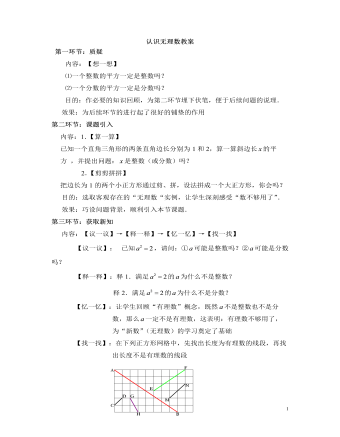
北师大初中数学八年级上册认识无理数2教案
本节课中教师首先用拼图游戏引发学生学习的欲望,把课程内容通过学生的生活经验呈现出来,然后进行大胆置疑,生活中的数并不都是有理数,那它们究竟是什么数呢?从而引发了学生的好奇心,为获取新知,创设了积极的氛围.在教学中,不要盲目的抢时间,让学生能够充分的思考与操作.(二)化抽象为具体常言道:“数学是锻炼思维的体操”,数学教师应通过一系列数学活动开启学生的思维,因此对新数的学习不能仅仅停留于感性认识,还应要求学生充分理解,并能用恰当数学语言进行解释.正是基于这个原因,在教学过程中,刻意安排了一些环节,加深对新数的理解,充分感受新数的客观存在,让学生觉得新数并不抽象.(三)强化知识间联系,注意纠错既然称之为“新数”,那它当然不是有理数,亦即不是整数,也不是分数,所以“新数”不可以用分数来表示,这为进一步学习“新数”,即第二课时教学埋下了伏笔,在教学中,要着重强调这一点:“新数”不能表示成分数,为无理数的教学奠好基.
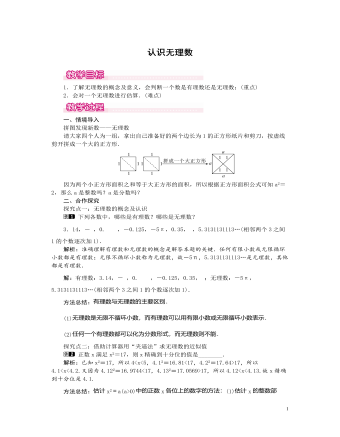
北师大初中数学八年级上册认识无理数1教案
解:有理数:3.14,-53,0.58··,-0.125,0.35,227;无理数:-5π,5.3131131113…(相邻两个3之间1的个数逐次加1).方法总结:有理数与无理数的主要区别.(1)无理数是无限不循环小数,而有理数可以用有限小数或无限循环小数表示.(2)任何一个有理数都可以化为分数形式,而无理数则不能.探究点二:借助计算器用“夹逼法”求无理数的近似值正数x满足x2=17,则x精确到十分位的值是________.解析:已知x2=17,所以417,所以4.117,所以4.120)中的正数x各位上的数字的方法:(1)估计x的整数部分,看它在哪两个连续整数之间,较小数即为整数部分;(2)确定x的十分位上的数,同样寻找它在哪两个连续整数之间;(3)按照上述方法可以依次确定x的百分位、千分位、…上的数,从而确定x的值.
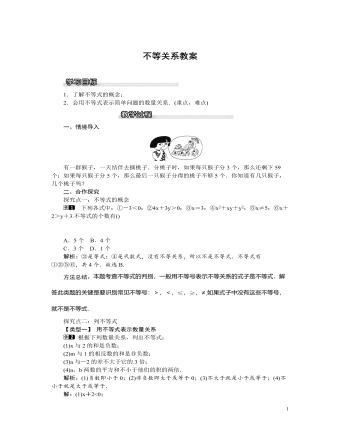
北师大初中八年级数学下册不等关系教案
A.20x-55≥350 B.20x+55≥350C.20x-55≤350 D.20x+55≤350解析:此题中的不等关系:现在已存有55元,计划从现在起以后每个月节省20元.若此学生平板电脑至少需要350元.列出不等式20x+55≥350.故选B.方法总结:用不等式表示数量关系时,要找准题中表示不等关系的两个量,并用代数式表示;正确理解题中的关键词,如负数、非负数、正数、大于、不大于、小于、不小于、不足、不超过、至少、至多等的含义.三、板书设计1.不等式的概念2.列不等式(1)找准题目中不等关系的两个量,并且用代数式表示;(2)正确理解题目中的关键词语的确切含义;(3)用与题意符合的不等号将表示不等关系的两个量的代数式连接起来;(4)要正确理解常见不等式基本语言的含义.本节课通过实际问题引入不等式,并用不等式表示数量关系.要注意常用的关键词的含义:负数、非负数、正数、大于、不大于、小于、不小于、不足、不超过,这些关键词中如果含有“不”“非”等文字,一般应包括“=”,这也是学生容易出错的地方.
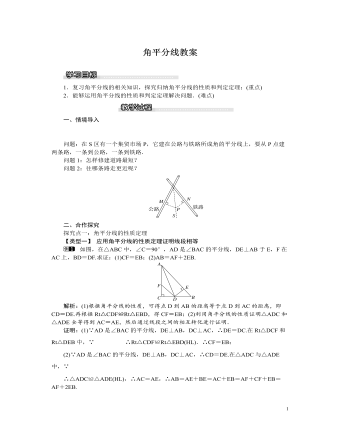
北师大初中八年级数学下册角平分线教案
解:(1)∵AB、CD互相垂直平分,∴OC=OD,AO=OB,且AC=BC=AD=BD;(2)OE=OF,理由如下:在△AOC和△AOD中,∵AC=AD,OC=OD,AO=AO,∴△AOC≌△AOD(SSS),∴∠CAO=∠DAO.又∵OE⊥AC,OF⊥AD,∴OE=OF.方法总结:本题是线段垂直平分线的性质和角平分线的性质的综合,掌握它们的适用条件和表示方法是解题的关键.三、板书设计1.角平分线的性质定理角平分线上的点到这个角的两边的距离相等.2.角平分线的判定定理在一个角的内部,到角的两边距离相等的点在这个角的平分线上.本节课由于采用了动手操作以及讨论交流等教学方法,从而有效地增强了学生对角以及角平分线的性质的感性认识,提高了学生对新知识的理解与感悟,因而本节课的教学效果较好,学生对所学的新知识掌握较好,达到了教学的目的.不足之处是少数学生在性质的运用上还存在问题,需要在今后的教学与作业中进一步的加强巩固和训练.
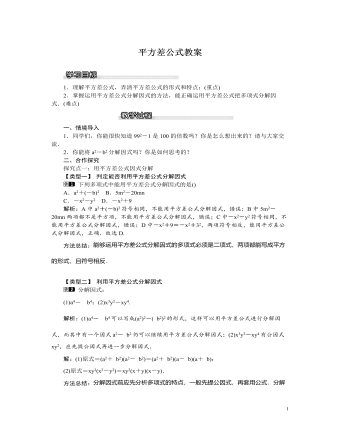
北师大初中八年级数学下册平方差公式教案
答:所有阴影部分的面积和是5050cm2.方法总结:首先应找出图形中哪些部分发生了变化,是按照什么规律变化的,通过分析找到各部分的变化规律后直接利用规律求解.探寻规律要认真观察、仔细思考,善用联想来解决这类问题.三、板书设计1.平方差公式:a2-b2=(a+b)(a-b);2.平方差公式的特点:能够运用平方差公式分解因式的多项式必须是二项式,两项都能写成平方的形式,且符号相反.运用平方差公式因式分解,首先应注意每个公式的特征.分析多项式的次数和项数,然后再确定公式.如果多项式是二项式,通常考虑应用平方差公式;如果多项式中有公因式可提,应先提取公因式,而且还要“提”得彻底,最后应注意两点:一是每个因式要化简,二是分解因式时,每个因式都要分解彻底.
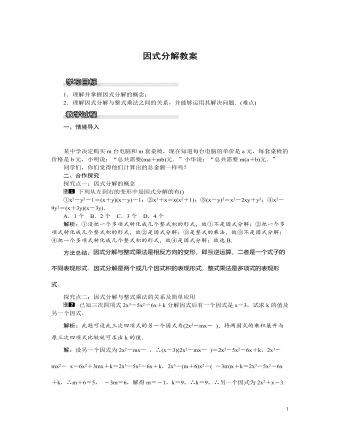
北师大初中八年级数学下册因式分解教案
解:设另一个因式为2x2-mx-k3,∴(x-3)(2x2-mx-k3)=2x3-5x2-6x+k,2x3-mx2-k3x-6x2+3mx+k=2x3-5x2-6x+k,2x3-(m+6)x2-(k3-3m)x+k=2x3-5x2-6x+k,∴m+6=5,k3-3m=6,解得m=-1,k=9,∴k=9,∴另一个因式为2x2+x-3.方法总结:因为整式的乘法和分解因式互为逆运算,所以分解因式后的两个因式的乘积一定等于原来的多项式.三、板书设计1.因式分解的概念把一个多项式转化成几个整式的积的形式,这种变形叫做因式分解.2.因式分解与整式乘法的关系因式分解是整式乘法的逆运算.本课是通过对比整式乘法的学习,引导学生探究因式分解和整式乘法的联系,通过对比学习加深对新知识的理解.教学时采用新课探究的形式,鼓励学生参与到课堂教学中,以兴趣带动学习,提高课堂学习效率.
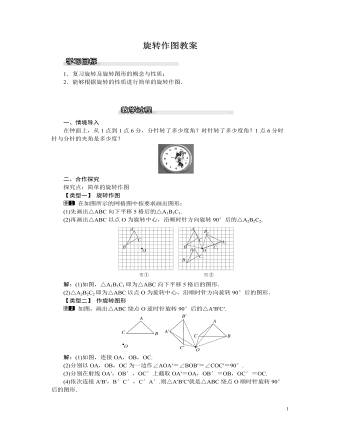
北师大初中八年级数学下册旋转作图教案
解析:整个阴影部分比较复杂和分散,像此类问题通常使用割补法来计算.连接BD、AC,由正方形的对称性可知,AC与BD必交于点O,正好把左下角的阴影部分分成(Ⅰ)与(Ⅱ)两部分(如图②),把阴影部分(Ⅰ)绕点O逆时针旋转90°至阴影部分①处,把阴影部分(Ⅱ)绕点O顺时针旋转90°至阴影部分②处,使整个阴影部分割补成半个正方形.解:如图②,把阴影部分(Ⅰ)绕点O逆时针旋转90°至阴影部分①处,把阴影部分(Ⅱ)绕点O顺时针旋转90°至阴影部分②处,使原阴影部分变为如图②的阴影部分,即正方形的一半,故阴影部分面积为12×10×10=50(cm2).方法总结:本题是利用旋转的特征:旋转前、后图形的形状和大小不变,把图形利用割补法补全为一个面积可以计算的规则图形.三、板书设计1.简单的旋转作图2.旋转图形的应用教学过程中,强调学生自主探索和合作交流,经历观察、归纳和动手操作,利用旋转的性质作图.

人教版新课标小学数学四年级下册四则运算复习课说课稿
(三)、自主检测 评价完善1、自主检测现在我们要开始攀登主峰了,道路是崎岖的,我相信同学们能够克服重重困难登顶成功,只要细心,你就能行。学生独立完成习题。(设计意图:我这样设计练习,既重视基础知识的训练,又将知识性与趣味性融合为一体,学生兴趣盎然,积极参与。数学课因为有了学生的积极参与而拥有了生命力。)2、评价完善一生汇报答案,其余自我核对,矫正错误。(设计意图:我这样设计练习,既重视基础知识的训练,又将知识性与趣味性融合为一体,学生兴趣盎然,积极参与。数学课因为有了学生的积极参与而拥有了生命力。)(四)、归纳小结 课外延伸1、归纳小结这节课我们主要学习了什么内容?你最大的收获是什么?你觉得自己的表现怎么样?教师适时的对学生的学习情况作以情感性和知识性评价。
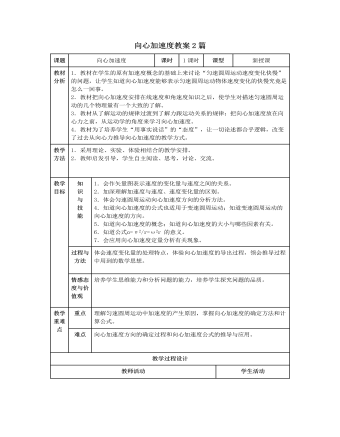
人教版新课标高中物理必修2向心加速度教案2篇
1.教材在学生的原有加速度概念的基础上来讨论“匀速圆周运动速度变化快慢”的问题,让学生知道向心加速度能够表示匀速圆周运动物体速度变化的快慢究竟是怎么一回事。2.教材把向心加速度安排在线速度和角速度知识之后,使学生对描述匀速圆周运动的几个物理量有一个大致的了解。3.教材从了解运动的规律过渡到了解力跟运动关系的规律;把向心加速度放在向心力之前,从运动学的角度来学习向心加速度。4.教材为了培养学生“用事实说话”的“态度”,让一切论述都合乎逻辑,改变了过去从向心力推导向心加速度的教学方式。1.采用理论、实验、体验相结合的教学安排。2.教师启发引导,学生自主阅读、思考,讨论、交流。知识与技能1.会作矢量图表示速度的变化量与速度之间的关系。2.加深理解加速度与速度、速度变化量的区别。3.体会匀速圆周运动向心加速度方向的分析方法。4.知道向心加速度的公式也适用于变速圆周运动;知道变速圆周运动的向心加速度的方向。
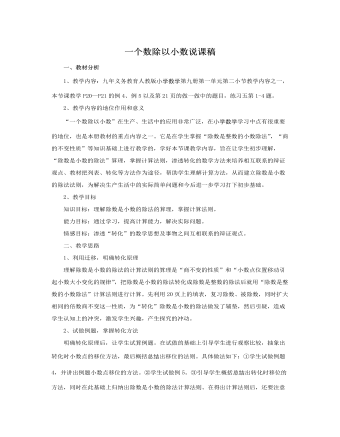
人教版新课标小学数学五年级上册一个数除以小数说课稿
(由除数的小数位决定。因为我们只要把除数转化成整数就成了除数是整数的小数除法。如:0.756÷0.18=75.6÷18。)(设计意图:在试做的基础上引导学生初步感受转化时小数点的移位方法,为自主概括法则作铺垫)2、学习例5:买0.75千克油用10.5元。每千克油的价格是多少元?学生列式:10.5÷0.75。①要把除数0.75变成整数,怎样转化?(把除数0.75扩大100倍转化成75。要使商不变,被除数也应扩大100倍。)②被除数10.5扩大100倍是多少?(10.5扩大100倍是1050,小数部分位数不够在末尾被“0”。)3、比较例4与例5有什么不同?(被除数在移动小数点时,位数不够在末尾用“0”补足。)4、练习:课本P21练一练第2题,学生独立完成后,归纳小结。(设计意图:对被除数小数点移位后补“0”的方法,教师可作适当点拨。学生试做后先不急于讲评,让他们对照教材中的两个例题启发学生观察、比较两道例题的不同点与计算时的注意点。引导学生分析、比较,逐步抽象出移位的方法。)
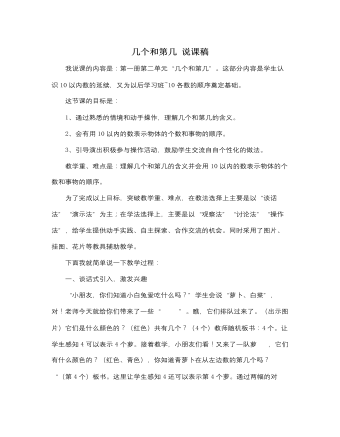
人教版新课标小学数学一年级上册几个和第几 说课稿
为了让学生灵活地掌握知识,在这我设计了一个“摆花片“的活动,让学生拿出1个黄色花片和7个红色花片,学生任意摆成一行,摆好后说一说是怎样摆的,黄花片摆在第几,并鼓励学生向同桌介绍一下自已的摆法。(通过这一活动,培养费了学生的动手能力,语言表达能力和思维能力)四、巩固练习1、基础练习:课本23页练一练第1题,“共有()朵花,从左数分别把第2朵和第6朵涂上不同的颜色,让学生进一步巩固几个和第几的含义。2、针对性练习:右以让学生说说各位车手的名次,再连线,这道题的侧重点是比赛地顺序。有针对性的巩固第几的含义。3、综合应用练习:最后组织学生做游戏,从左数第3排的同学站起来;对着老师这排的前4个同学丫起来,对着老师这排的第5个同学举一下手等等。通过游戏让学生巩固几个和第几的含义,同时让学生感受爱到数学就在身边。五、全课小结:通过这节课的学心,你有什么收获?总之,这节课我让学生动口、动脑、动手,在精心设计的数学活动中学习数学。
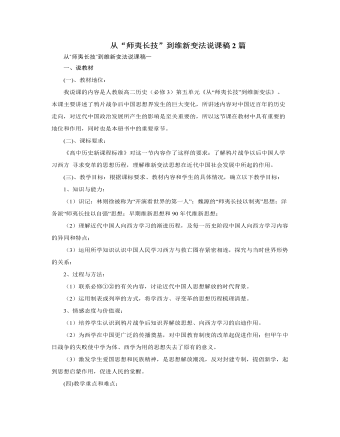
人教版高中历史必修3从“师夷长技”到维新变法说课稿2篇
(一)、教材地位:我说课的内容是人教版高二历史(必修3)第五单元《从“师夷长技”到维新变法》。本课主要讲述了鸦片战争后中国思想界发生的巨大变化,所讲述内容对中国近百年的历史走向,对近代中国政治发展所产生的影响是至关重要的,所以这节课在教材中具有重要的地位和作用,同时也是本册书中的重要章节。(二)、课标要求:《高中历史新课程标准》对这一节内容作了这样的要求:了解鸦片战争以后中国人学习西方 寻求变革的思想历程,理解维新变法思想在近代中国社会发展中所起的作用。(三)、教学目标:根据课标要求、教材内容和学生的具体情况,确立以下教学目标:1、知识与能力:(1)识记:林则徐被称为“开演看世界的第一人”;魏源的“师夷长技以制夷”思想;洋务派“师夷长技以自强”思想;早期维新思想和90年代维新思想;

新人教版高中英语选修2Unit 1 Science and Scientists-Discovering useful structures教学设计
The grammatical structure of this unit is predicative clause. Like object clause and subject clause, predicative clause is one of Nominal Clauses. The leading words of predicative clauses are that, what, how, what, where, as if, because, etc.The design of teaching activities aims to guide students to perceive the structural features of predicative clauses and think about their ideographic functions. Beyond that, students should be guided to use this grammar in the context apporpriately and flexibly.1. Enable the Ss to master the usage of the predicative clauses in this unit.2. Enable the Ss to use the predicative patterns flexibly.3. Train the Ss to apply some skills by doing the relevant exercises.1.Guide students to perceive the structural features of predicative clauses and think about their ideographic functions.2.Strengthen students' ability of using predicative clauses in context, but also cultivate their ability of text analysis and logical reasoning competence.Step1: Underline all the examples in the reading passage, where noun clauses are used as the predicative. Then state their meaning and functions.1) One theory was that bad air caused the disease.2) Another theory was that cholera was caused by an infection from germs in food or water.3) The truth was that the water from the Broad Street had been infected by waste.Sum up the rules of grammar:1. 以上黑体部分在句中作表语。2. 句1、2、3中的that在从句中不作成分,只起连接作用。 Step2: Review the basic components of predicative clauses1.Definition

新人教版高中英语选修2Unit 4 Journey Across a Vast Land教学设计
当孩子们由父母陪同时,他们才被允许进入这个运动场。3.过去分词(短语)作状语时的几种特殊情况(1)过去分词(短语)在句中作时间、条件、原因、让步状语时,相当于对应的时间、条件、原因及让步状语从句。Seen from the top of the mountain (=When it is seen from the top of the mountain), the whole town looks more beautiful.从山顶上看,整个城市看起来更美了。Given ten more minutes (=If we are given ten more minutes), we will finish the work perfectly.如果多给十分钟,我们会完美地完成这项工作。Greatly touched by his words (=Because she was greatly touched by his words), she was full of tears.由于被他的话深深地感动,她满眼泪花。Warned of the storm (=Though they were warned of the storm), the farmers were still working on the farm.尽管被警告了风暴的到来,但农民们仍在农场干活。(2)过去分词(短语)在句中作伴随、方式等状语时,可改为句子的并列谓语或改为并列分句。The teacher came into the room, followed by two students (=and was followed by two students).后面跟着两个学生,老师走进了房间。He spent the whole afternoon, accompanied by his mom(=and was accompanied by his mom).他由母亲陪着度过了一整个下午。

新人教版高中英语选修2Unit 1 Science and Scientists-Learning about Language教学设计
Step 7: complete the discourse according to the grammar rules.Cholera used to be one of the most 1.__________ (fear) diseases in the world. In the early 19th century, _2_________ an outbreak of cholera hit Europe, millions of people died. But neither its cause, 3__________ its cure was understood. A British doctor, John Snow, wanted to solve the problem and he knew that cholera would not be controlled _4_________ its cause was found. In general, there were two contradictory theories 5 __________ explained how cholera spread. The first suggested that bad air caused the disease. The second was that cholera was caused by an _6_________(infect) from germs in food or water. John Snow thought that the second theory was correct but he needed proof. So when another outbreak of cholera hit London in 1854, he began to investigate. Later, with all the evidence he _7_________ (gather), John Snow was able to announce that the pump water carried cholera germs. Therefore, he had the handle of the pump _8_________ (remove) so that it couldn't be used. Through his intervention,the disease was stopped in its tracks. What is more, John Snow found that some companies sold water from the River Thames that __9__________________ (pollute) by raw waste. The people who drank this water were much more likely _10_________ (get) cholera than those who drank pure or boiled water. Through John Snow's efforts, the _11_________ (threaten) of cholera around the world saw a substantial increase. Keys: 1.feared 2.when 3. nor 4.unless 5.that/which 6.infection 7.had gathered 8.removed 9.was polluted 10.to get 11. threat

新人教版高中英语选修2Unit 1 Science and Scientists-Reading and thinking教学设计
Step 5: After learning the text, discuss with your peers about the following questions:1.John Snow believed Idea 2 was right. How did he finally prove it?2. Do you think John Snow would have solved this problem without the map?3. Cholera is a 19th century disease. What disease do you think is similar to cholera today?SARS and Covid-19 because they are both deadly and fatally infectious, have an unknown cause and need serious public health care to solve them urgently.keys:1. John Snow finally proved his idea because he found an outbreak that was clearly related to cholera, collected information and was able to tie cases outside the area to the polluted water.2. No. The map helped John Snow organize his ideas. He was able to identify those households that had had many deaths and check their water-drinking habits. He identified those houses that had had no deaths and surveyed their drinking habits. The evidence clearly pointed to the polluted water being the cause.3. SARS and Covid-19 because they are both deadly and fatally infectious, have an unknown cause and need serious public health care to solve them urgently.Step 6: Consolidate what you have learned by filling in the blanks:John Snow was a well-known _1___ in London in the _2__ century. He wanted to find the _3_____ of cholera in order to help people ___4_____ it. In 1854 when a cholera __5__ London, he began to gather information. He ___6__ on a map ___7___ all the dead people had lived and he found that many people who had ___8____ (drink) the dirty water from the __9____ died. So he decided that the polluted water ___10____ cholera. He suggested that the ___11__ of all water supplies should be _12______ and new methods of dealing with ____13___ water be found. Finally, “King Cholera” was __14_____.Keys: 1. doctor 2. 19th 3.cause 4.infected with 5.hit 6.marked 7.where 8.drunk 9.pump 10.carried 11.source 12.examined 13.polluted 14.defeatedHomework: Retell the text after class and preview its language points

新人教版高中英语选修2Unit 1 Science and Scientists-Using langauge教学设计
This happens because the dish soap molecules have a strong negative charge, and the milk molecules have a strong positive charge. Like magnets, these molecules are attracted to each other, and so they appear to move around on the plate, taking the food coloring with them, making it look like the colors are quickly moving to escape from the soap.Listening text:? Judy: Oh, I'm so sorry that you were ill and couldn't come with us on our field trip. How are you feeling now? Better?? Bill: Much better, thanks. But how was it?? Judy: Wonderful! I especially liked an area of the museum called Light Games.it was really cool. They had a hall of mirrors where I could see myself reflected thousands of times!? Bill: A hall of mirrors can be a lot of fun. What else did they have?? Judy: Well, they had an experiment where we looked at a blue screen for a while, and then suddenly we could see tiny bright lights moving around on it. You'll never guess what those bright lights were!? Bill: Come on, tell me!? Judy: They were our own blood cells. For some reason, our eyes play tricks on us when we look at a blue screen, and we can see our own blood cells moving around like little lights! But there was another thing I liked better. I stood in front of a white light, and it cast different shadows of me in every color of the rainbow!? Bill: Oh, I wish I had been there. Tell me more!? Judy: Well, they had another area for sound. They had a giant piano keyboard that you could use your feet to play. But then, instead of playing the sounds of a piano, it played the voices of classical singers! Then they had a giant dish, and when you spoke into it, it reflected the sound back and made it louder. You could use it to speak in a whisper to someone 17 meters away.? Bill: It all sounds so cool. I wish I could have gone with you? Judy: I know, but we can go together this weekend. I'd love to go there again!? Bill: That sounds like a great idea!

新人教版高中英语选修2Unit 2 Bridging Cultures-Discovering useful structures教学设计
The grammar of this unit is designed to review noun clauses. Sentences that use nouns in a sentence are called noun clauses. Nominal clauses can act as subject, object, predicate, appositive and other components in compound sentences. According to the above-mentioned different grammatical functions, nominal clauses are divided into subject clause, object clause, predicate clause and appositive clause. In this unit, we will review the three kinds of nominal clauses. Appositive clauses are not required to be mastered in the optional compulsory stage, so they are not involved.1. Guide the students to judge the compound sentences and determine the composition of the clauses in the sentence.2. Instruct students to try to learn grammar by generalizing grammar rules, controlling written practice, and semi-open oral output.3. Inspire the students to systematize the function and usage of noun clause1.Instruct students to try to learn grammar by generalizing grammar rules, controlling written practice, and semi-open oral output.2.Inspire the students to systematize the function and usage of noun clauseStep1: The teacher ask studetns to find out more nominal clauses from the reading passage and udnerline the nominal clauses.